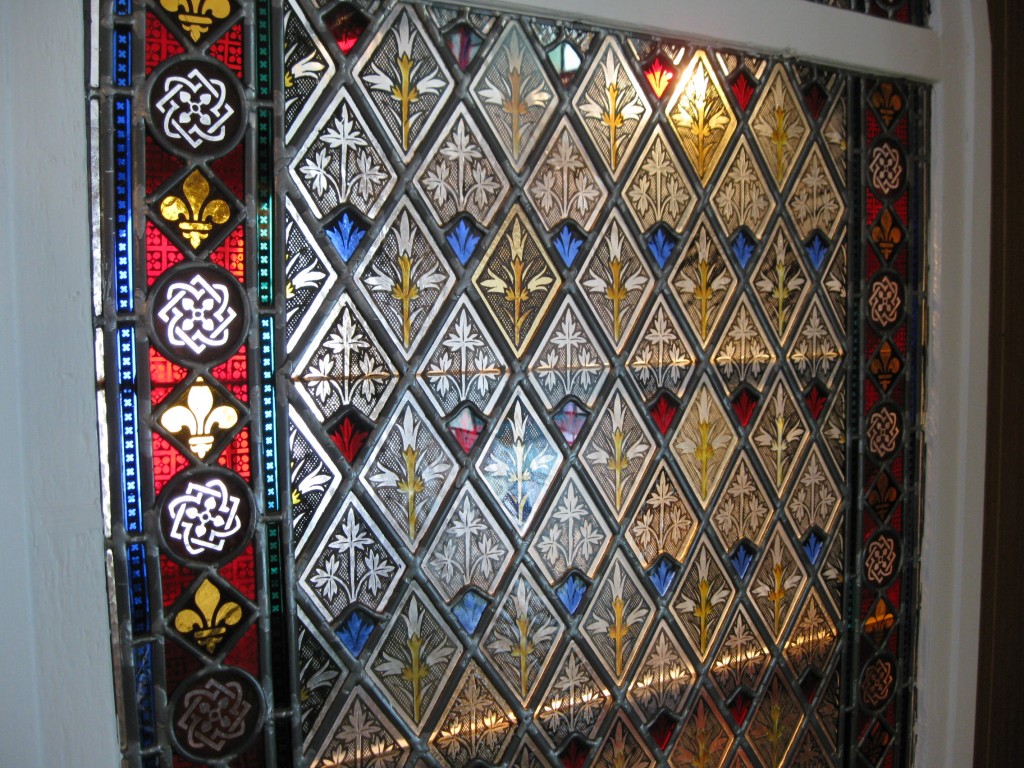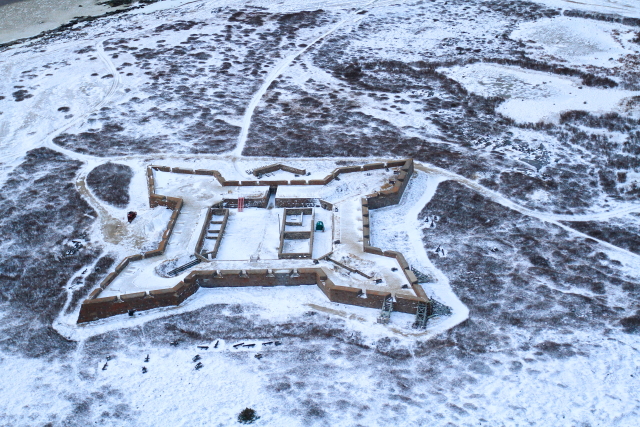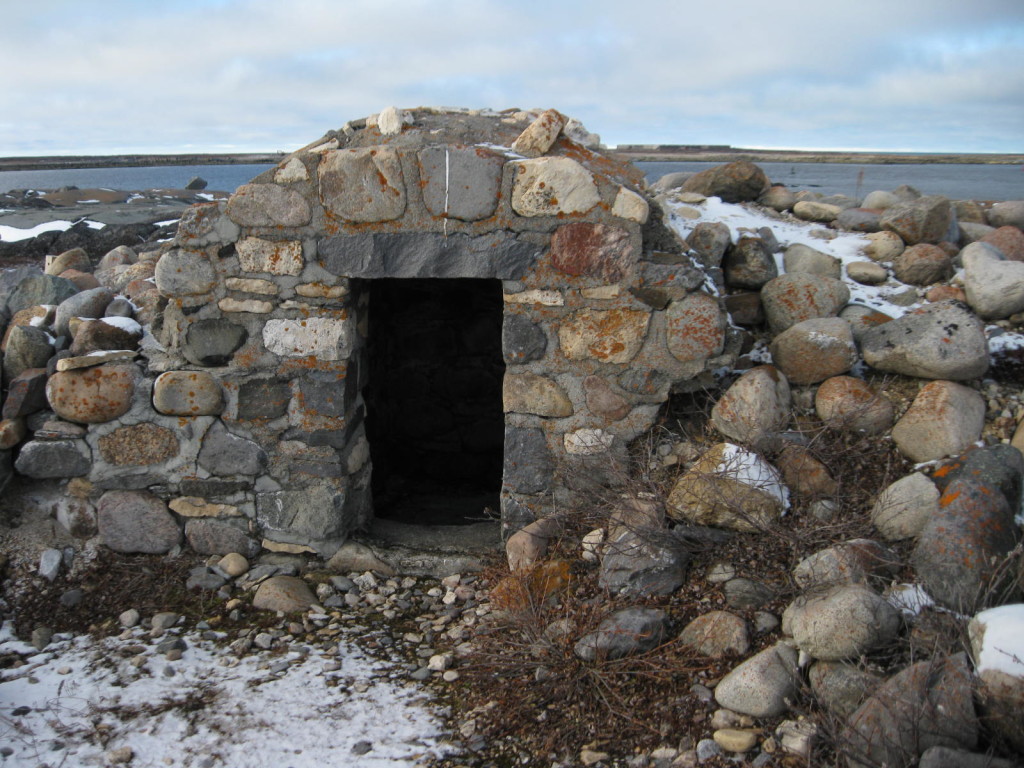by Steve Selden | Jun 8, 2015 | Churchill News
The winter dive on the HMS Erebus, Sir john Franklin’s long lost but now found ship, went well but is only “scratching the surface” according to senior researchers on the expedition.
Divers were literally scratching the surface of the sunken ship. Removing the kelp that covered the old wooden hull was the first task to be able to get a better look at the wreck in relation to the overall site. Rather than strip it all away from the entire ship they cut it off only along the port side of the 34-meter long wooden vessel.
Although the Erebus has not disclosed much information about its fate as of yet, clearing the hull and mapping the site has provided more of a story.

Jonathan Moore drilling the ice for a dive hole at Erebus Dive Camp. Parks Canada photo.
Parcs Canada senior underwater archeologist Ryan Harris says the artifacts recovered so far “can help capture what life was like inside Erebus, as well as perhaps on the still-missing second ship of the Franklin expedition, HMS Terror.” Brass buttons, a cannon and ceramic dinner plates have all been discovered and are currently on display with a dozen other items in Gatineau, Quebec.

Brass buttons discovered can be narrowed down to only four crewmen. Parks Canada photo.

Ceramic dinner plates found at the Erebus wreck site. Parcs Canada photo.
In another mysterious and intriguing twist to the expedition, glass prisms were placed inside the upper deck which focused a very small amount light streaming through a skylight, and allowed that daylight to pass through, into the dark spaces below.
“It looks like something out of Jules Verne,” Harris says. “At this point in time, we’re absolutely just scratching the surface of what we might learn from this shipwreck,”

A cannon from the HMS Erebus is pulled to the surface through one of the dive holes cut in two-meter thick ice. Jonathan Moore/ Parcs Canada photo.
by Steve Selden | Apr 8, 2015 | Conservation
Diving on the site of the HMS Erebus shipwreck will resume this month in the high Arctic. Sir John Franklin’s ill fated voyage to find the northwest passage came to an end nearly 170 years ago as the Erebus was trapped in ice for two years off Prince William Island in Queen Maude Gulf near Nunavut.

A Parks Canada diver measures part of the Franklin expedition’s Erebus on Sept 18, 2014. Thierry Boyer/Parks Canada photo.
Franklin’s 1846 expedition had two ships; the HMS Erebus and HMS Terror. No sign of either has been evident for nearly a century and a half. Seven months ago the Erebus was discovered by a group of private-public searchers lead by Parc’s Canada. Now the next chapter is unfolding.

HMS Erebus and HMS Terror, shown in the Illustrated London News published on May 24, 1845, left England that year under the command of Sir John Franklin and in the search of the Northwest Passage. Courtesy London News/Getty Images.
The irony of this continued expedition and salvage project is that the divers will be descending through two meters of ice to reach the bottom of the gulf. The same ice was responsible for crushing the wooden ship and sending it to the ocean floor a century and a half ago. The benefit here will be that the thick six foot layer of ice will eliminate surface waves and almost all water movement around the wreck therefore keeping any sediment and particulate from clouding the water. Clear visibility will enhance the efficiency of the divers time in the -2 C icy water.
These clear conditions will be most beneficial for the operation of the new 3D laser scanning apparatus archeologists will utilize to produce incredibly detailed images of the Erebus lying 11 meters below the surface. The main goal for this expedition is to create a comprehensive baseline recording or map of the wreck site before continuing on with possible salvage work.
Current dive site plans call for 14-hour dive days from 8 AM- 10 PM over a 10 day period. Divers outfitted with specialized dry suits will be able to dive for over an hour at a time. Two-person dive teams comprised of one Parcs Canada member and one navy member will be deployed in steady succession.
Aside from mapping the site, crews will also try to gain valuable insight by probing an extension camera into nooks and holes in the Erebus to get an inside look into the past.
Churchill has been the focus of countless exploratory expeditions from Europe over the centuries and now a discovery that has captivated the world has also touched this remote outpost on the Hudson Bay. The Anglican church in Churchill is home to a gift from Sir John Franklin’s widow in appreciation of all the efforts from countless men in searching for her husbands lost expedition throughout the north. It appears now that this ancient mystery has been solved.

Lady Franklin stained glass window. Karen Walker photo.
Come to Churchill and see the Franklin stained glass window and the the mighty polar bear!
by Steve Selden | Dec 18, 2014 | Churchill News

Fort Prince of Wales on the West side of the Churchill River.
If you venture to Churchill in the summertime with Natural Habitat Adventures there’s a good chance you’ll travel cross-river and tour Fort Prince of Wales with a guided interpretation from a Parcs Canada ranger. An intriguing and somewhat comical history endures.
In 1717, just a few years after the Treaty of Utrecht returned all Hudson Bay posts to England, James Knight from the Hudson Bay Company built the ” Churchill River Post” and it was renamed “Prince of Wales” two years later. The initial trading post/fort was constructed to pretty much take advantage geographically of the more northern location and general accessibility to multiple regional fur traders and native trappers.

Ammunition cache at Cape Merry for cannon protection of Fort prince of Wales. Karen Walker photo.
With the ongoing feud and battle to control the fur industry between the french and English, the need for a stronghold of greater security seemed like a good idea.
In 1731 construction of the current day Fort Prince of Wales began out on Eskimo Point at the mouth of the Churchill River. A mere 40 years later the four-meter-thick stone walls were completed and the 40 cannon mounts were in place. Nearly unbearable winter living conditions made the construction process less than expeditious. With the sparseness of trees in the area, gathering firewood for heat also was a laborious task. If we could hear the stories from those days.

A view across the Cape Merry barrens past the battery and to Fort prince of Wales.
The star fort design, originally conceptualized in the mid-15th century in Italy worked quite well in covering all angles of attack with cannons. Walls were constructed low and thick to withstand cannon fire. A deep ditch surrounding the fort was to compensate for the lower walls.
The grand irony of the entire project culminated in 1782 when three French warships commanded by general La Perouse captured the fort without a single shot being fired. During the whole construction process, the minor details of training the stationed men how to fire a cannon seemed to slip through the cracks. Again, with the severe weather conditions, one can only imagine how basic survival during construction trumped all other endeavors.
In 1934 the process of reconstructing the partially demolished and downtrodden fort began. That process has restored the fort to a most presentable condition. In recent years, an intense archeological effort has produced incredible artifacts used to paint a more vivid picture of life in the 18th century.
by Steve Selden | Oct 28, 2012 | Churchill News, Tour News
When Natural Habitat guide Karen Walker and group arrived in Churchill this past week they found clear blue skies, no wind and calm waters. That scenario is changing as this post is being published. For all the polar bear watchers out there that is good news. As many travelers do upon arriving in Churchill, the group followed the coast road out around the inlet across from Miss Piggy taking in the amazing Hudson Bay vastness. Arriving back in town they stopped at the large Inukshuk on the beach behind the town complex for another view out over the calm bay slapping waves against the shore. After lunch ,desserts and a taste of local flavor at Gypsy’s, they checked into the hotel and headed over to Parcs Canada Visitor Center for an orientation to the polar bear world and regional geographic and cultural features. Karen added her orientation thoughts to a fantastic presentation by well-known Raymond’s from Parcs presentation. Peter and Mary rounded out a full afternoon of northern exposure!

Two polar bears spar in front of a pond, Brad Josephs photo,
After dinner, stars were in the northern sky so the avid bunch headed out behind the complex once again to find a faint arch or northern lights fairly low on the horizon. It was a nice evening along the shores of Hudson Bay. About 45 minutes later, the arch brightened significantly and began to form a swirling motion seemingly mimicking the counter-clockwise currents of the tumultuous Hudson Bay. Nothing can match the experience of these lights of the north!
As morning came the group headed to the tundra and immediately spotted a pair of ptarmigan in the willows heading out to the lodge. Four bears were in the area and soon after arrival some sparring ensued just off the tail end of the rover. “We had a bear come up to our rover. Then we headed out the point a ways and watched a couple of bears wander off into the willows along the ponds.” reported guide Karen. ” I gave an intro to polar bears, then suddenly one, no two bears, appeared from the willows & headed right toward us. We were visited by the bears & had them under the deck. They never stood up on our rover or sniffed the deck, but it was still awesome to look them in the eye.” Another unforgettable memory.
Once the two polar bears headed off, lunch was served. just as most had finished, they appeared again. Perfect timing! With beautiful views of the colorful yellow and red tundra the bears lingered near the rover during the morning as big snow flakes started to fly … some even found their way into the rover when the windows were down. A preview of the imminent snow in the forecast. On the trip back to launch-site, a offshoot voyage to Halfway Point provided an amazing view of a puffy, white snowy owl. What a way to complete an incredible day in the CWMA.

Snowy owl checking out the humans. Candice Gaukel Andrews photo.
The group staying on the tundra lodge with guide Rinnie had incredible sparring after some docile, napping bears the first couple of days. The sunlight accentuated the movement as the bears grappled right next to viewing platforms. Later as the rover ventured away from the lodge, a sow with two yearlings – first sightings of the season- came right up to the machine two different times. With no other rover in sight, this encounter made the trip for many of the guests. Back at the lodge in the evening…stellar aurora borealis graced the skies above…a perfect day and night on the tundra lodge.
Guide Elise and her travelers were near the lodge most of that same day as the wind blew snow squalls sideways. Sparring bears continued to battle while taking rests and then resuming nearly all day. One bear had an injured claw and spewed blood on white fur adding to the drama. Exciting action as the snow moves in across the region.
EARLY SEASON BIRD REPORT
Bonnie Chartier spends most of polar bear season out at the tundra lodge with travelers eager to get amazing round the clock views of polar bears. However, Bonnie also is one of the premier experts on Arctic birdlife. She has literally written a book called “A Birders Guide to Churchill ” and continues her research on the numerous species that call Churchill home for all or part of the year. Here’s her report of sightings out in the Churchill Wildlife Management Area (CWMA). Some of these species have most likely made their way south by now..but for the birders in the crowd here’s the skinny:
“In the past few days we had at least 6 different Snowy Owls. Also well photographed was a single white Gyrfalcon. Rock Ptarmigan are being seen in good size flocks. Shore birds include Pectoral Sandpipers, Dunlin, Black-bellied Plovers. Snow buntings are still around in good numbers. There are Canada Geese, Common Eider, Long-tailed Ducks and a few Red-breasted Mergansers still hanging about. I saw only one greater Yellowlegs. “
If there are any species still out on the tundra Bonnie will find them. Stay tuned for another mid-season update!













